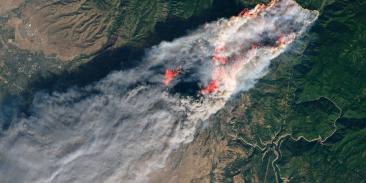New study shows how sectoral emissions shape today’s warming and tomorrow’s risks
Researchers unpack the push and pull of warming and cooling forces and their implications for climate policy
A new study published in npj Climate and Atmospheric Science analyzes the impact of seven economic sectors to current temperature changes, based on their historical emissions.
The paper, “Considering sectoral warming and cooling emissions and their lifetimes can improve climate change mitigation policies,” examines the delicate interplay between short- and long-lived climate warmers as well as coolers to determine each sector’s contributions to the rise in current and future temperatures. It also shows how coolers temporarily mask warming emissions. The findings underscore the importance of considering the entire system of influences.
The authors quantified 33 emitted species since 1750 from seven economic sectors (agriculture, fossil fuel production and distribution, industry, buildings, transportation, waste and power generation). They calculated the species’ impact on present day warming—the increased temperatures we are feeling today—and assessed how present-day emissions would be felt in the future.
Sectors that predominately emit short-lived warmers like methane drive more than half of today’s net warming. Due to their short lifespan and the lack of co-emitted coolers, targeting these sectors is key for quick benefits to the climate. Sectors that are major sources of carbon dioxide, like industry or power generation, in contrast, are also major sources of coolers that mask 50-80% of their warming today. While coolers may seem beneficial, their masking is short-lived, and the CO2 warming can persist for centuries. They also harm the environment in other ways.
Coolers come with consequences
Most coolers are, or help generate, short-lived particles (known as aerosols) that can reflect incoming sunlight and increase the lifetime and brightness of clouds. This can lead to slightly lower regional and even global temperatures. But this has a cost. Coolers lead to air pollution, causing health problems and even death.
This is why countries have implemented policies and worked for decades to improve air quality, particularly in places like China, which has made big strides in reducing air pollution. But as emissions of coolers are reduced, the full warming impact of that co-emitted carbon dioxide is unmasked. So, while near-term benefits of mitigating sectors that predominantly emit carbon dioxide are somewhat limited, it is still essential for creating a safer climate in the long term.
“Smart and practical strategies to quickly and effectively reduce both near- and long-term warming requires good, science-based policies that consider the interplay between all emissions. That’s what the atmosphere really sees, and it is the whole mix that impacts our climate,” said Brian Buma, Senior Climate Scientist at Environmental Defense Fund.
Influence of agriculture, power generation change dramatically when considering lifespan
Emissions from agriculture and fossil fuel production and distribution, dominated by methane, are each driving around a quarter of today’s experienced (net) warming. However, because methane is short-lived, that warming impact is from “recent” emissions, or the last few decades. This represents an opportunity, because if we continue to emit methane the impact on the climate will also continue, the impact of today’s emissions does not last long. If we slash methane emissions now, we can almost immediately benefit the climate.
For example, agriculture’s share of warming in 100 years from current emissions will drop to 6%. There are also opportunities for major air quality improvements, because methane emissions lead to the formation of ground-level ozone that is toxic to humans and plants.
For sectors dominated by CO2, the story is different. The power sector is only driving around 4% of current net warming, because those co-emitted coolers mask most of the CO2-caused warming. Yet because those coolers have a short lifespan on the order of days to weeks, and CO2 has a very long lifespan of potentially centuries, that masking disappears. The influence of the power sector’s present-day emissions to warming triples to 12% in 10 years, and in 100 years grows to 34%. Reducing emissions from these sectors is therefore critical for long-term climate stability.
“Our study shows why we must cut emissions across all sectors,” said Ilissa Ocko, Senior Climate Scientist, Spark Climate Solutions. “And it also shows why we must consider the full suite of emissions—warmers and coolers; short-lived and long-lived; greenhouse gases and aerosols, and their precursors—in climate frameworks. Only then will we be aware of the full climate impact of our actions, and thus be able to make the most effective decisions for a safer climate,” she added.
With more than 3 million members, Environmental Defense Fund creates transformational solutions to the most serious environmental problems. To do so, EDF links science, economics, law, and innovative private-sector partnerships to turn solutions into action. edf.org
Latest press releases
-
Governor Hochul Repeals "100-Foot Rule," Accelerating New York's Clean Energy Future
December 19, 2025 -
Colorado Air Regulators Approve Landfill Methane Standards
December 18, 2025 -
Proposal Would Guarantee Public Access to Air Quality Data
December 18, 2025 -
New Bill Will Help Keep Domestic Manufacturers Competitive
December 17, 2025 -
Satellite Data Shows Colorado Oil & Gas Methane Emissions Dropped as State Rules Took Effect
December 17, 2025 -
EDF Europe: Energy Council Signals Shift to Delivery on EU Methane Regulation
December 17, 2025











